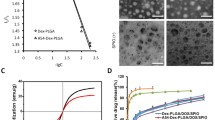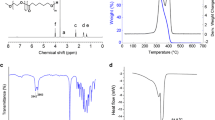Abstract
Theranostic nanosystem has been demonstrated great potential in real-timely monitoring drug biodistribution and therapeutic response. It is still a challenge to fabricate a theranostic nanosystem that possesses the properties of good biocompatibility, a high magnetic resonance imaging (MRI) sensitivity, and stimuli-responsive drug release for the diagnosis and treatment of hepatocellular carcinoma. Here, a pH-responsive micelle, which was self-assembled from biodegradable poly(amino acid) block copolymer mPEG-PAsp(DIP)-co-PLLeu, was constructed to load both chemotherapeutic paclitaxel (PTX) and MRI contrast agent superparamagnetic iron oxide nanoparticles (SPIONs). The SPIONs/PTX-coloaded PDPL micelle (SPIONs/PTX-PDPL) had a hydrodynamic particle size of 134.5 ± 11.2 nm. The theranostic SPIONs/PTX-PDPL not only effectively delivered PTX and SPION into Bel-7402 cancer cells but also rapidly released PTX in acidic lysosome to induce cell apoptosis. Meanwhile, in vitro MR imaging sensitively detected the liver cancer cells after co-incubation with SPIONs/PTX-PDPL micelle. The SPIONs/PTX-PDPL micelle is a potential theranostic nanosystem in terms of the simultaneous chemotherapy and MR imaging of hepatocellular carcinoma.

A novel pH-responsive polymeric micelle was synthesized to co-deliver chemotherapy drug paclitaxel (PTX) and MRI contrast agent superparamagnetic iron oxide nanoparticles (SPIONs) for simultaneous chemotherapy and MR imaging of hepatocellular carcinoma.









Similar content being viewed by others
Change history
11 November 2023
A Correction to this paper has been published: https://doi.org/10.1007/s11051-023-05871-7
References
Ai H, Flask C, Weinberg B, Shuai XT, Pagel MD, Farrell D, Duerk J, Gao J (2005) Magnetite-loaded polymeric micelles as ultrasensitive magnetic-resonance probes. Adv Mater 17:1949–1952. https://doi.org/10.1002/adma.200401904
Bae Y, Kataoka K (2009) Intelligent polymeric micelles from functional poly(ethylene glycol)-poly(amino acid) block copolymers. Adv Drug Deliv Rev 61:768–784 http://www.sciencedirect.com/science/article/pii/S0169409X09001410
Cao Y, Liu M, Zhang K, Zu G, Kuang Y, Tong X, Xiong D, Pei R (2017) Poly(glycerol) used for constructing mixed polymeric micelles as T1 MRI contrast agent for tumor-targeted imaging. Biomacromolecules 18:150–158. https://doi.org/10.1021/acs.biomac.6b01437
Dai J, Lin S, Cheng D, Zou S, Shuai X (2011) Interlayer-crosslinked micelle with partially hydrated core showing reduction and pH dual sensitivity for pinpointed intracellular drug release. Angew Chem Int Ed Eng 50:9404–9408. https://doi.org/10.1002/anie.201103806
El-Bassuony AAH, Abdelsalam HK (2018a) Attractive improvement in structural, magnetic, optical, and antimicrobial activity of silver delafossite by Fe/Cr doping. J Supercond Nov Magn 31:3691–3703. https://doi.org/10.1007/s10948-018-4627-6
El-Bassuony AAH, Abdelsalam HK (2018b) Enhancement of AgCrO2 by double nanometric delafossite to be applied in many technological applications. J Mater Sci Mater Electron 29:5401–5412. https://doi.org/10.1007/s10854-017-8506-x
El-Bassuony AAH, Abdelsalam HK (2018c) Giant exchange bias of hysteresis loops on Cr3+-doped Ag nanoparticles. J Supercond Nov Magn 31:1539–1544. https://doi.org/10.1007/s10948-017-4340-x
El-Bassuony AAH, Abdelsalam HK (2018d) Synthesis, characterization and antimicrobial activity of AgFeO2 delafossite. J Mater Sci Mater Electron 29:11699–11711. https://doi.org/10.1007/s10854-018-9268-9
El-Bassuony AAH, Abdelsalam HK (2019a) Fascinating study of the physical properties of a novel nanometric delafossite for biomedical applications. JOM 71:1866–1873. https://doi.org/10.1007/s11837-019-03415-w
El-Bassuony AAH, Abdelsalam HK (2019b) Tailoring the structural, magnetic and antimicrobial activity of AgCrO2 delafossite at high annealing temperature. J Therm Anal Calorim 138:81–88. https://doi.org/10.1007/s10973-019-08207-7
El-Bassuony AAH, Abdelsalam HK (2020a) Correlation of heat treatment and the impurities accompanying Ag nanoparticles. Eur Phys J Plus 135:66–12. https://doi.org/10.1140/epjp/s13360-019-00025-y
El-Bassuony AAH, Abdelsalam HK (2020b) Impacts of hematite, bunsenite and maghemite impurities on the physical and antimicrobial properties of silver nanoparticles. Eur Phys J Plus 135:64–17. https://doi.org/10.1140/epjp/s13360-020-00139-8
El-Bassuony AAH, Abdelsalam HK (2020c) Synthesis, characterization, magnetic and antimicrobial properties of silver chromite nanoparticles. J Mater Sci Mater Electron 31:3662–3673. https://doi.org/10.1007/s10854-020-02924-8
Fu J, Wang H (2018) Precision diagnosis and treatment of liver cancer in China. Cancer Lett 412:283–288. https://doi.org/10.1016/j.canlet.2017.10.008
Green MR, Manikhas GM, Orlov S, Afanasyev B, Makhson AM, Bhar P, Hawkins MJ (2006) Abraxane((r)), a novel cremophor((r))-free, albumin-bound particle form of paclitaxel for the treatment of advanced non-small-cell lung cancer. Ann Oncol 17:1263–1268. https://doi.org/10.1093/annonc/mdl104
Gupta AK, Gupta M (2005) Synthesis and surface engineering of iron oxide nanoparticles for biomedical applications. Biomaterials 26:3995–4021. https://doi.org/10.1016/j.biomaterials.2004.10.012
Han S-S, Li Z-Y, Zhu J-Y, Han K, Zeng Z-Y, Hong W, Li W-X, Jia H-Z, Liu Y, Zhuo R-X, Zhang XZ (2015) Dual-pH sensitive charge-reversal polypeptide micelles for tumor-triggered targeting uptake and nuclear drug delivery. Small 11:2543–2554. https://doi.org/10.1002/smll.201402865
He C, Zhuang X, Tang Z, Tian H, Chen X (2012) Stimuli-sensitive synthetic polypeptide-based materials for drug and gene delivery. Adv Healthc Mater 1:48–78. https://doi.org/10.1002/adhm.201100008
Huang J, Lin C, Fang J, Li X, Wang J, Deng S, Zhang S, Su W, Feng X, Chen B, Cheng D, Shuai X (2018) pH-sensitive nanocarrier-mediated codelivery of simvastatin and noggin siRNA for synergistic enhancement of osteogenesis. ACS Appl Mater Interfaces 10:28471–28482. https://doi.org/10.1021/acsami.8b10521
Huang J, Xu Y, Xiao H, Xiao Z, Guo Y, Cheng D, Shuai X (2019) Core–shell distinct nanodrug showing on-demand sequential drug release to act on multiple cell types for synergistic anticancer therapy. ACS Nano 13:7036–7049. https://doi.org/10.1021/acsnano.9b02149
Kelkar SS, Reineke TM (2011) Theranostics: combining imaging and therapy. Bioconjug Chem 22:1879–1903. https://doi.org/10.1021/bc200151q
Liao J, Wei X, Ran B, Peng J, Qu Y, Qian Z (2017) Polymer hybrid magnetic nanocapsules encapsulating IR820 and PTX for external magnetic field-guided tumor targeting and multifunctional theranostics. Nanoscale 9:2479–2491. https://doi.org/10.1039/C7NR00033B
Liu Q, Zhu H, Qin J, Dong H, Du J (2014) Theranostic vesicles based on bovine serum albumin and poly(ethylene glycol)-block-poly(L-lactic-co-glycolic acid) for magnetic resonance imaging and anticancer drug delivery. Biomacromolecules 15:1586–1592. https://doi.org/10.1021/bm500438x
Mahmoudi M, Simchi A, Imani M, Shokrgozar MA, Milani AS, Häfeli UO, Stroeve P (2010) A new approach for the in vitro identification of the cytotoxicity of superparamagnetic iron oxide nanoparticles. Colloids Surf B: Biointerfaces 75:300–309. https://doi.org/10.1016/j.colsurfb.2009.08.044
McGlynn KA, London WT (2011) The global epidemiology of hepatocellular carcinoma: present and future. Clin Liver Dis 15:223–243. https://doi.org/10.1016/j.cld.2011.03.006
Mi P, Dewi N, Yanagie H, Kokuryo D, Suzuki M, Sakurai Y, Li Y, Aoki I, Ono K, Takahashi H, Cabral H, Nishiyama N, Kataoka K (2015) Hybrid calcium phosphate-polymeric micelles incorporating gadolinium chelates for imaging-guided gadolinium neutron capture tumor therapy. ACS Nano 9:5913–5921. https://doi.org/10.1021/acsnano.5b00532
Nakanishi M, Park J-S, Jang W-D, Oba M, Kataoka K (2007) Study of the quantitative aminolysis reaction of poly(β-benzyl L-aspartate) (PBLA) as a platform polymer for functionality materials. React Funct Polym 67:1361–1372. https://doi.org/10.1016/j.reactfunctpolym.2007.08.009
Roy A, Singh MS, Upadhyay P, Bhaskar S (2013) Nanoparticle mediated co-delivery of paclitaxel and a TLR-4 agonist results in tumor regression and enhanced immune response in the tumor microenvironment of a mouse model. Int J Pharm 445:171–180. https://doi.org/10.1016/j.ijpharm.2013.01.045
Sahay G, Alakhova DY, Kabanov AV (2010) Endocytosis of nanomedicines. J Control Release 145:182–195. https://doi.org/10.1016/j.jconrel.2010.01.036
Sayed MA, Abdelsalam HK, El-Bassuony AAH (2020) Antimicrobial activity of novel spinel nanoferrites against pathogenic fungi and bacteria. World J Microbiol Biotechnol 36:25. https://doi.org/10.1007/s11274-020-2803-x
Schleich N, Sibret P, Danhier P, Ucakar B, Laurent S, Muller RN, Jérôme C, Gallez B, Préat V, Danhier F (2013) Dual anticancer drug/superparamagnetic iron oxide-loaded PLGA-based nanoparticles for cancer therapy and magnetic resonance imaging. Int J Pharm 447:94–101. https://doi.org/10.1016/j.ijpharm.2013.02.042
Singh S, Dash AK (2009) Paclitaxel in cancer treatment: perspectives and prospects of its delivery challenges. Crit Rev Ther Drug Carrier Syst 26:333–372. https://doi.org/10.1615/CritRevTherDrugCarrierSyst.v26.i4.10
Sofias AM, Dunne M, Storm G, Allen C (2017) The battle of “nano” paclitaxel. Adv Drug Deliv Rev 122:20–30. https://doi.org/10.1016/j.addr.2017.02.003
Sun S, Zeng H, Robinson DB, Raoux S, Rice PM, Wang SX, Li G (2004) Monodisperse MFe2O4 (M = Fe, Co, Mn) nanoparticles. J Am Chem Soc 126:273–279. https://doi.org/10.1021/ja0380852
Szebeni J, Alving CR, Muggia FM (1998) Complement activation by cremophor EL as a possible contributor to hypersensitivity to paclitaxel: an in vitro study. J Nati Cancer I 90:300–306. https://doi.org/10.1093/jnci/90.4.300
Verma A, Stellacci F (2010) Effect of surface properties on nanoparticle–cell interactions. Small 6:12–21. https://doi.org/10.1002/smll.200901158
Wang W, Cheng D, Gong F, Miao X, Shuai X (2012) Design of multifunctional micelle for tumor-targeted intracellular drug release and fluorescent imaging. Adv Mater 24:115–120. https://doi.org/10.1002/adma.201104066
Wen X, Wang Y, Zhang F, Zhang X, Lu L, Shuai X, Shen J (2014) In vivo monitoring of neural stem cells after transplantation in acute cerebral infarction with dual-modal MR imaging and optical imaging. Biomaterials 35:4627–4635. https://doi.org/10.1016/j.biomaterials.2014.02.042
Wu J, Huang J, Kuang S, Chen J, Li X, Chen B, Wang J, Cheng D, Shuai X (2019) Synergistic microRNA therapy in liver fibrotic rat using MRI-visible nanocarrier targeting hepatic stellate cells. Adv Sci 6:1801809. https://doi.org/10.1002/advs.201801809
Yang JD, Hainaut P, Gores GJ, Amadou A, Plymoth A, Roberts LR (2019) A global view of hepatocellular carcinoma: trends, risk, prevention and management. Nat Rev Gastroenterol Hepatol 16:589–604. https://doi.org/10.1038/s41575-019-0186-y
Yang X, Grailer JJ, Rowland IJ, Javadi A, Hurley SA, Steeber DA, Gong S (2010) Multifunctional SPIO/DOX-loaded wormlike polymer vesicles for cancer therapy and MR imaging. Biomaterials 31:9065–9073. https://doi.org/10.1016/j.biomaterials.2010.08.039
Yu H, Zou Y, Wang Y, Huang X, Huang G, Sumer BD, Boothman DA, Gao J (2011) Overcoming endosomal barrier by amphotericin B-loaded dual pH-responsive PDMA-b-PDPA micelleplexes for siRNA delivery. ACS Nano 5:9246–9255. https://doi.org/10.1021/nn203503h
Funding
This work was supported by the National Natural Science Foundation of China (81701812, 21905112), the Research Foundation of Zhejiang Chinese Medical University (2018ZR05), and the Science and Technology Foundation of Wenzhou City (Y20140725).
Author information
Authors and Affiliations
Corresponding authors
Ethics declarations
Conflict of interest
The authors declare that they have no conflicts of interest.
Additional information
Publisher’s note
Springer Nature remains neutral with regard to jurisdictional claims in published maps and institutional affiliations.
Rights and permissions
Springer Nature or its licensor (e.g. a society or other partner) holds exclusive rights to this article under a publishing agreement with the author(s) or other rightsholder(s); author self-archiving of the accepted manuscript version of this article is solely governed by the terms of such publishing agreement and applicable law.
About this article
Cite this article
Xiao, H., Li, X., Zheng, C. et al. Intracellular pH-responsive polymeric micelle for simultaneous chemotherapy and MR imaging of hepatocellular carcinoma. J Nanopart Res 22, 105 (2020). https://doi.org/10.1007/s11051-020-04821-x
Received:
Accepted:
Published:
DOI: https://doi.org/10.1007/s11051-020-04821-x




